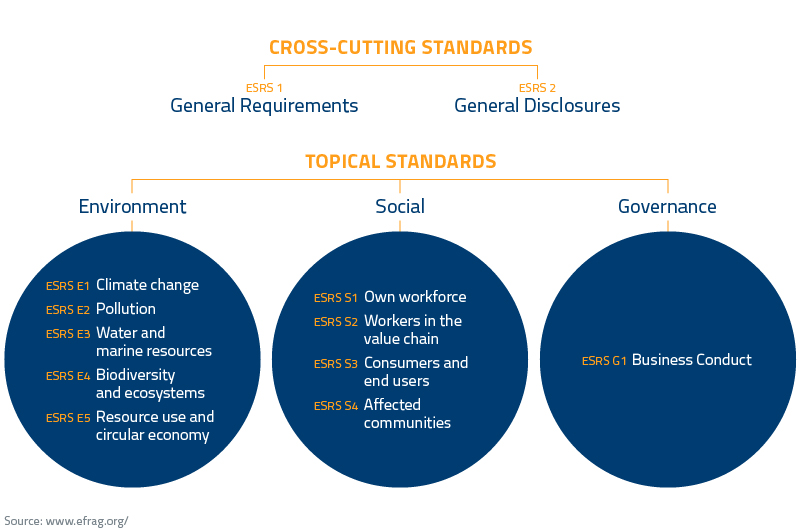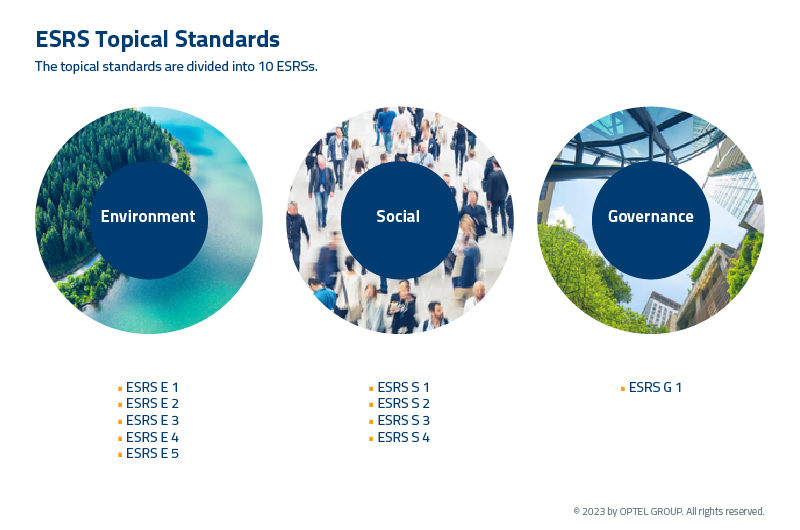
THE EU DELAYS CSRD REPORTING STANDARDS BY TWO YEARS
On January 24, 2024, the European Parliament’s Legal Affairs Committee voted 21-2 to partially defer the implementation of the Corporate Sustainable Reporting Directive (CSRD) for specific business sectors and companies based both inside and outside of the EU. The delay extends the deadline for adopting these standards by two years to June 2026.
WHY WERE CSRD REPORTING DEADLINES PUSHED BACK?
This move is part of the EU Commission’s 2024 Work Programme aimed at lessening the reporting burden on companies. It is a response to the need for more time to develop high-quality sector-specific European Sustainability Reporting Standards (ESRS) and to give companies adequate time to adapt to the general ESRS set earlier.
BACKGROUND ON ESRS AND EU PARLIAMENT’S INVOLVEMENT
EU Sustainability Reporting Standards (ESRS) detail the requirements under the CSRD. They are divided into two cross-cutting standards (ESRS 1 and ESRS 2), which address how companies should prepare their reports and set out the disclosure requirements that apply to all, and 10 other standards divided into the ESG themes: environmental, social and governance. While the first set of general ESRS was adopted in July 2023, specific industry-related standards were expected by June 2024. Similarly, large non-EU businesses operating within the EU were initially scheduled to adopt these rules by the same date, with reporting due to start in 2028.
Members of the European Parliament (MEPs) have called for improved transparency and flexibility in the standard-setting process, requesting annual consultations with the Parliament on the progress of the standards’ development by the European Financial Reporting Advisory Group (EFRAG).
According to Axel Voss, the committee’s rapporteur: “We will delay the deadline for sector-specific standards under the Corporate Sustainability Reporting Directive (CSRD) by two years in order to give EFRAG the time to develop quality standards and give companies the time to put them into practice. Companies have been putting up with too much bureaucracy in years of crisis, from Covid to inflation.”
Despite the delay, MEPs have urged that the new standards be published as soon as they are ready, even if before the new deadline, to facilitate transparency and comparability between companies. These standards are seen as crucial for providing investors with valuable information, particularly in areas like decarbonization, biodiversity, and human rights, which can vary by sector.

FOCUS ON ESRS 1 AND ESRS 2
Although a section of the CSRD deadlines have shifted, understanding the ESRS’ is still of essence. Companies remain obligated to comply with the essential cross-cutting standards; ESRS 1 & ESRS 2.
ESRS 1
The objective of ESRS 1 is to outline the general requirements companies need to comply with when preparing and presenting sustainability-related information under the CSRD. Put simply, ESRS 1 presents the obligations regarding the preparation and reporting of this information.
ESRS 1 begins by explaining that the disclosed information should enable the understanding of companies’ environmental, social, and governance impact. It progresses into explaining a list of mandatory information that companies need to disclose across all sustainability topics, which are:
- ESRS 2 general disclosures
- EU legislation datapoints
- E1 climate change
- S1 own-workforce disclosure requirements (DR)
In addition to the above, businesses must conduct a materiality assessment. This means that if a topic is deemed ‘material,’ it has a significant impact on stakeholders’ decisions and perceptions, requiring additional disclosure. For topics considered ‘not material,’ businesses will be required to provide a brief explanation as to how it has concluded the ‘non-materiality’ of the topic.
Another key component mentioned in ESRS 1 is the value chain, which requires businesses to provide information on the material impact, risks and opportunities linked to their company through their business relationships in the upstream and/or downstream value chain. In cases where a company cannot collect the information about their upstream and downstream value chain, they should estimate the information to be reported, by using all reasonable and supportable information.
The complexities inherent in both the materiality assessment and value chain aspects within ESRS 1, have motivated EFRAG to release their initial set of three draft ESRS Implementation Guidance documents for public feedback:

ESRS 2
ESRS 2 outsets the basis for preparation (BP) of the sustainability statements, which is divided into two sections called BP1 and BP2.
BP1 requires information on:
- whether the statements have been prepared on a consolidated or individual basis
- if the scope of consolidation is the same as for the financial statements
- to what extent the sustainability statements cover the undertaking’s upstream and downstream value chain
- whether the business has used the option to omit a specific piece of information
- a statement for businesses that have an exemption from disclosure
BP2 addresses the effect of specific circumstances in preparing the sustainability statements. For example, when a company uses estimated data from indirect sources as their metrics, they should identify these metrics and describe the basis for preparation, along with the resulting level of accuracy and planned actions to improve accuracy in the future. BP2 sets out 7 of these circumstances: (i) time horizons, (ii) value chain estimation (as described above), (iii) sources of estimation and outcome uncertainty, (iv) changes in preparation or presentation of sustainability information, (v) reporting errors in prior periods, (vi) disclosures stemming from local legislation or generally accepted sustainability reporting pronouncements, and (vii) incorporation by reference. This information may be presented alongside the disclosures to which they refer.
ESRS 2 goes on to describe the four reporting areas that will be used under the CSRD: (i) governance, (ii) strategy, (iii) impact, risks and opportunity management, and (iv) metrics and targets. All topical standards follow the same four-pillar approach in terms of structure and content.

CONCLUSION
Following the plenary’s consent, the committee’s approval paves the way for the European Parliament to begin final negotiations on the legislation with EU member states.
OPTEL will continue to monitor the situation closely and provide our clients with updated information as it becomes available. If you have any questions on what this delay means for your company, download our latest guide.
DOWNLOAD GUIDEYOU MAY ALSO BE INTERESTED IN READING

Products Impacted by The EUDR
The list of products / commodities that fall under the EU Deforestation Regulation (EUDR) can be found in Annex I of the regulation.

Double Materiality Assessments Under the EU’s CSRD
The concept of double materiality assessments is at the heart of the CSRD and ESRS. Let’s explore the double materiality requirement under the CSRD.

Overview of European Environmental Regulations and Frameworks
The European Union is at the forefront of integrating sustainability into policies. Navigating these regulations can be complex, here’s a summary on EU ESG regulations.

